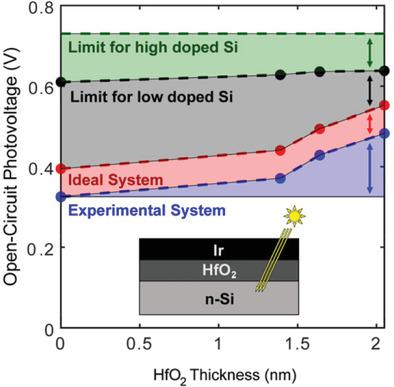当前位置:
X-MOL 学术
›
Adv. Energy Mater.
›
论文详情
Our official English website, www.x-mol.net, welcomes your
feedback! (Note: you will need to create a separate account there.)
Quantifying Losses and Assessing the Photovoltage Limits in Metal–Insulator–Semiconductor Water Splitting Systems
Advanced Energy Materials ( IF 24.4 ) Pub Date : 2020-02-09 , DOI: 10.1002/aenm.201903354 John Hemmerling 1 , Joseph Quinn 1 , Suljo Linic 1
Advanced Energy Materials ( IF 24.4 ) Pub Date : 2020-02-09 , DOI: 10.1002/aenm.201903354 John Hemmerling 1 , Joseph Quinn 1 , Suljo Linic 1
Affiliation

|
Metal–insulator–semiconductor (MIS) photo‐electrocatalysts offer a pathway to stable and efficient solar water splitting. Initially motivated as a strategy to protect the underlying semiconductor photoabsorber from harsh operating conditions, the thickness of the insulator layer in MIS systems has recently been shown to be a critical design parameter which can be tuned to optimize the photovoltage. This study analyzes the underlying mechanism by which the thickness of the insulator layer impacts the performance of MIS photo‐electrocatalysts. A concrete example of an Ir/HfO2/n‐Si MIS system is investigated for the oxygen evolution reaction. The results of combined experiments and modeling suggest that the insulator thickness affects the photovoltage i) favorably by controlling the flux of charge carriers from the semiconductor to the metal electrocatalyst and ii) adversely by introducing nonidealities such as surface defect states which limit the generated photovoltage. It is important to quantify these different mechanisms and suggest avenues for addressing these nonidealities to enable the rational design of MIS systems that can approach the fundamental photovoltage limits. The analysis described in this contribution as well as the strategy toward optimizing the photovoltage are generalizable to other MIS systems.
中文翻译:

量化损耗并评估金属-绝缘体-半导体水分解系统中的光电压极限
金属-绝缘体-半导体(MIS)光电催化剂为稳定和高效地分解太阳能提供了一条途径。最初是作为保护底层半导体光吸收剂免受恶劣操作条件影响的一种策略,最近已证明MIS系统中绝缘层的厚度是关键的设计参数,可以对其进行调整以优化光电压。这项研究分析了绝缘层厚度影响MIS光电催化剂性能的潜在机理。Ir / HfO 2的具体例子对/ n-Si MIS系统进行了析氧反应的研究。组合实验和建模的结果表明,绝缘体厚度会影响光电压:i)通过控制电荷载流子从半导体到金属电催化剂的流动,有利地影响光电压; ii)通过引入非理想性(例如限制产生的光电压的表面缺陷状态)不利地影响光电压。重要的是量化这些不同的机制,并提出解决这些非理想性的途径,以使能够接近基本光电压极限的MIS系统的合理设计成为可能。此贡献中描述的分析以及优化光电压的策略可推广到其他MIS系统。
更新日期:2020-03-27
中文翻译:

量化损耗并评估金属-绝缘体-半导体水分解系统中的光电压极限
金属-绝缘体-半导体(MIS)光电催化剂为稳定和高效地分解太阳能提供了一条途径。最初是作为保护底层半导体光吸收剂免受恶劣操作条件影响的一种策略,最近已证明MIS系统中绝缘层的厚度是关键的设计参数,可以对其进行调整以优化光电压。这项研究分析了绝缘层厚度影响MIS光电催化剂性能的潜在机理。Ir / HfO 2的具体例子对/ n-Si MIS系统进行了析氧反应的研究。组合实验和建模的结果表明,绝缘体厚度会影响光电压:i)通过控制电荷载流子从半导体到金属电催化剂的流动,有利地影响光电压; ii)通过引入非理想性(例如限制产生的光电压的表面缺陷状态)不利地影响光电压。重要的是量化这些不同的机制,并提出解决这些非理想性的途径,以使能够接近基本光电压极限的MIS系统的合理设计成为可能。此贡献中描述的分析以及优化光电压的策略可推广到其他MIS系统。











































 京公网安备 11010802027423号
京公网安备 11010802027423号